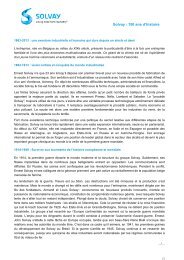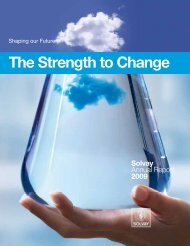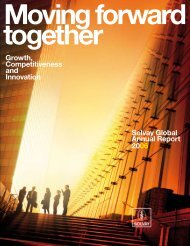solvay_live243_p02a04 somEdito
solvay_live243_p02a04 somEdito
solvay_live243_p02a04 somEdito
You also want an ePaper? Increase the reach of your titles
YUMPU automatically turns print PDFs into web optimized ePapers that Google loves.
Dossier<br />
105061<br />
44<br />
VIRTUAL SERVER PROJECT SAVES TIME<br />
AND MONEY FOR INTERNAL CUSTOMERS<br />
AT SOLVAY PHARMACEUTICALS<br />
A VIRTUAL SERVER<br />
FOR TANGIBLE GAINS<br />
SolvayInnovationTrophy2006<br />
As a general rule, the development<br />
of a new IT application implies the<br />
acquisition and configuration of new servers<br />
(up to three in fact: development, test,<br />
production) in order to guarantee the total<br />
isolation of the existing application so<br />
as not to threaten its integrity. The<br />
innovation consists of “virtualising” part of<br />
an existing server, that is, isolating one part<br />
and endowing it with all the functions of a<br />
completely autonomous server, for the<br />
applications or development. This operation<br />
has been applied at Marietta (US),<br />
with runaway success. The virtualisation<br />
of servers allows the creation of an IT<br />
environment for a new application within<br />
hours, rather than weeks, for a fraction<br />
of the cost of real servers.<br />
At Marietta alone, 91 virtual servers are<br />
in operation on only 8 real machines, which<br />
amounts to a reduction factor of 11.<br />
The setting up of virtual servers is now in<br />
progress in other Solvay Pharmaceuticals<br />
sites, Weesp (Netherlands), Hanover<br />
(Germany) and for the 3S project.<br />
> Scott Fouche; Ron Criswell; Mike Gerety;<br />
Earl Hartsell; Bruce Mc Millan; Fabian Gonzalez;<br />
Ruben Gabbarrini.<br />
> PHARMACEUTICALS SECTOR<br />
105043<br />
IMPROVED PROCESS TO TAB<br />
USING “GREEN CHEMISTRY”<br />
PRODUCE TAB CHEAPER<br />
AND WITHOUT RESIDUES<br />
TAB (tert-amylbenzene) is the basic raw<br />
material that goes into the production<br />
of amylantraquinone (AQ), itself an<br />
intermediary material for the production<br />
of Hydrogen Peroxyde (H202). Solvay, the<br />
world-wide leader in the production of TAB,<br />
AQ and H202, produces the TAB and AQ<br />
in its Linne Herten plant in the Netherlands.<br />
The demand for TAB is growing, in fact, it<br />
will double in five years’ time following the<br />
construction of new H202 production units,<br />
but the capacity at Linne Herten is saturated.<br />
The current TAB process suffers from several<br />
weaknesses: the use of hazardous<br />
substances, complexity and a large quantity<br />
of waste. The aim of the Solvay team, with<br />
the help of the KUL university of Louvain,<br />
was to develop a new organic synthesis<br />
of TAB without using nor benzene<br />
(carcinogenic) nor BF3 (highly toxic) but<br />
instead using ordinary raw materials, with<br />
a minimum of waste, a simplified reactor<br />
and more effective catalyst. The results are<br />
excellent: the new process uses green<br />
chemistry and is much more economical.<br />
The innovation is based on a new organic<br />
synthesis method and a “super basic<br />
“catalyser. It will reinforce Solvay’s cost<br />
leadership position with regard to its Chinese<br />
competitors. The installation will be up and<br />
running in September 2006 in Jemeppe<br />
(Belgium). In the meantime, a major contract<br />
for the sale of TAB has already been<br />
concluded with a Japanese company that will<br />
buy 100% of its needs from Solvay during<br />
a five years period.<br />
> Armin Liebens; Cyril Ausloos; Stephenhamer<br />
Bloomfield; Gilles Darago; Paul Deschrijver; Bernard<br />
Douillet; Jean-Pierre Ganhy; Bart Vercruysse.<br />
> SBU H 2 O 2<br />
105132<br />
HELLAS – ELECTRONIC LABORATORY NOTEBOOK<br />
THE USER-FRIENDLINESS<br />
OF PAPER, THE POWER<br />
OF ELECTRONICS<br />
The traditional paper laboratory notebooks<br />
are reaching to their limits: the difficulty<br />
of finding detailed information again,<br />
of rereading it, loss of information as a result<br />
of staff rotation, wasted duplication<br />
of experiments, etc.<br />
The “Chemical Development” departments<br />
in Weesp (Netherlands) have found an ideal<br />
solution, an electronic management system<br />
for chemical experiments in laboratories.<br />
By recording everything electronically in the<br />
same format, HELLAS (Human-friendly<br />
Electronic Laboratory Application System)<br />
pools all the information, all the knowledge<br />
on the projects underway, from the basic<br />
organic data, the analytical data,<br />
the molecular structures, to the experimental<br />
details, thus creating a “chemical memory”,<br />
accessible to all researchers. HELLAS is an<br />
internal development, based on software<br />
designed for the field of chemistry<br />
and that puts the emphasis on user-friendliness,<br />
both for data capture and for the<br />
information search via multiple keys. HELLAS<br />
contributes not only to the quality<br />
and reliability of data, but also to the improved<br />
management of all the projects, with,<br />
for example, the automatic generation of the<br />
experiment numbers, experiment reviews,<br />
project reviews... HELLAS has even brought<br />
about an improvement in multifunctional<br />
teamwork. The setting up of HELLAS has<br />
proved to be easy and fast. Four weeks was<br />
all it took. This system is already attracting<br />
interest from other departments, which have<br />
taken steps in this same direction.<br />
> Marcel Vanaar; Kees Bakker; Niek Buizer;<br />
Dick Doesburg; Jan Hoogendoorn; Hans Troost;<br />
Jacques Vanmelis.<br />
> PHARMACEUTICALS SECTOR


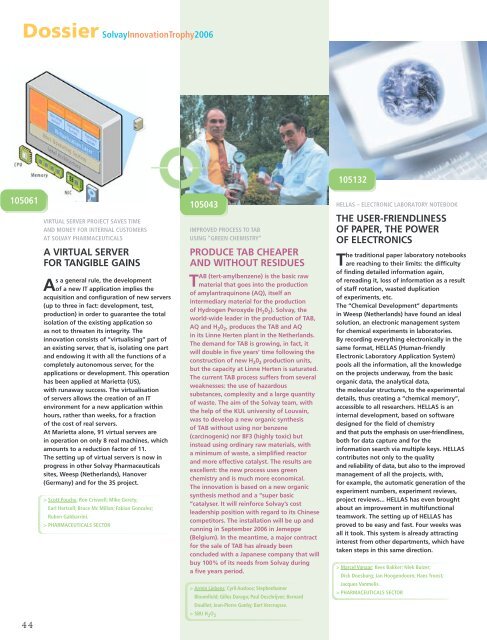

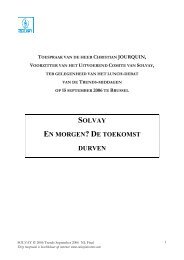
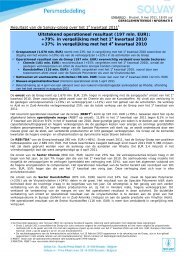

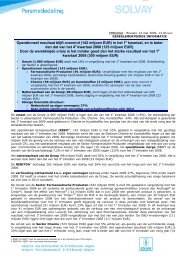
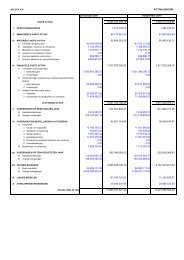

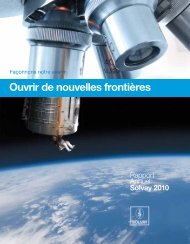
![PROC.1 [LETTRE] - Solvay](https://img.yumpu.com/16585746/1/184x260/proc1-lettre-solvay.jpg?quality=85)
